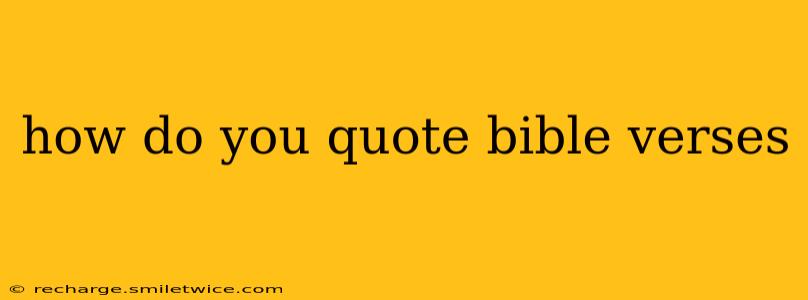How Do You Quote Bible Verses? A Guide to Accurate and Consistent Citation
Quoting Bible verses accurately and consistently is crucial for conveying your message clearly and avoiding misinterpretations. This guide will walk you through different methods, focusing on clarity and avoiding common pitfalls.
Choosing a Bible Version:
Before anything else, decide which Bible translation you'll use. Different translations have varying interpretations and word choices. Consistency is key; stick to a single version throughout your writing. Popular choices include the New International Version (NIV), English Standard Version (ESV), King James Version (KJV), and New Living Translation (NLT). Specify the version in a footnote or endnote if it's not obvious from context.
Methods of Quotation:
There are several ways to quote Bible verses, each with its own advantages:
1. In-Text Citation with Verse Numbers:
This is the most common method. It seamlessly integrates the quote into your text.
-
Example: "Love is patient, love is kind. It does not envy, it does not boast, it is not proud" (1 Corinthians 13:4, NIV).
-
Key elements: The verse numbers are enclosed in parentheses, following the quote. The version (NIV in this case) is included, usually the first time you cite a version in your writing. You can omit the version on subsequent citations if it's consistent throughout.
2. Block Quote for Longer Passages:
For longer quotes (generally four lines or more), use a block quote. This sets the quote apart visually.
- Example:
Love is patient, love is kind. It does not envy, it does not boast, it is not proud. It does not dishonor others, it is not self-seeking, it is not easily angered, it keeps no record of wrongs. Love does not delight in evil but rejoices with the truth. It always protects, always trusts, always hopes, always perseveres. (1 Corinthians 13:4-7, ESV)
- Key elements: Indent the entire passage. Put the citation at the end of the passage, outside the indentation.
3. Shortened Citations for Multiple Verses:
When citing multiple consecutive verses, you can use a hyphen or an ellipsis.
-
Example: The Sermon on the Mount is found in Matthew 5-7. (You can use this shortened notation for clarity and brevity if the audience is familiar with the passage).
-
Example: "Blessed are the poor in spirit, for theirs is the kingdom of heaven...Blessed are the meek, for they will inherit the earth" (Matthew 5:3,5, NIV). (Note: the ellipsis shows omitted text).
4. Reference only if not quoting directly:
If you are referring to a passage but not quoting it directly, you might include only the reference. For instance, “The teachings on love in 1 Corinthians 13 are profound.”
Tips for Accuracy and Clarity:
- Double-check your verses: Always verify your citations against your chosen Bible version.
- Maintain consistency: Use the same formatting and citation style throughout your work.
- Avoid misinterpretations: Be mindful of the context of the verses you quote. Don't take them out of context.
- Use ellipses sparingly: Only use ellipses (...) when omitting words from within a quote. Don't use them at the beginning or end unless necessary for context.
- Consider your audience: Adapt your citation style to the formality of your writing.
Frequently Asked Questions (PAAs):
How do I cite a Bible verse in an essay? The methods described above (in-text citations with verse numbers and block quotes for longer passages) are perfectly suitable for essays. Be consistent and include your Bible version at least once.
How do you quote the Bible in MLA format? MLA style generally follows the in-text citation method, placing the book, chapter, and verse in parentheses after the quote. For example: (Gen. 1:1). Specific formatting rules might apply depending on the publication. Check your style guide for details.
How do you cite the Bible in APA format? APA style is similar to MLA; book abbreviation, chapter, and verse go in parentheses. For Example: (John 3:16). Be sure to follow specific guidelines for your APA version.
How do you properly cite Bible verses in a research paper? Research papers usually require consistent citation throughout. Follow one of the established citation styles (MLA, Chicago, APA) or use a footnote/endnote system. Clearly identify the Bible version.
By following these guidelines, you can ensure your Bible quotes are accurate, clear, and contribute effectively to your writing. Remember that accurate citation is essential for academic honesty and theological integrity.
